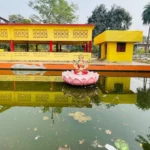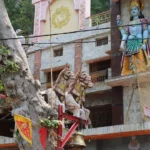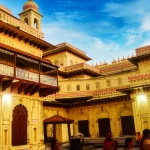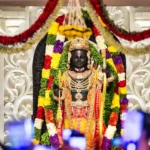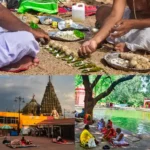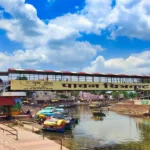History of Ayodhya – Things to Do in Ayodhya
Ayodhya’s history is a fascinating amalgamation of mythology, legend, and archaeological findings, making it a city of both historical and spiritual significance.
Mythological Origins – Things to Do in Ayodhya
In the mythological texts, Ayodhya is described as the birthplace of Lord Rama, a central figure in the Hindu epic, the Ramayana. The city is considered to be one of the seven sacred cities (‘Sapta Puri’) of Hinduism. It’s believed to have been the capital of the ancient Kosala Kingdom, ruled by the Ikshvaku dynasty, to which Lord Rama belonged.
Archaeological Insights – Things to Do in Ayodhya
Archaeological evidence presents a slightly different picture of Ayodhya. Excavations in the area suggest the presence of a settlement dating back several millennia. These findings indicate a simpler, more primitive lifestyle than the grandeur described in the Ramayana.

This dichotomy between the archaeological evidence and the mythological descriptions has led to fascinating discussions among historians and archaeologists about the city’s past.
Historical Accounts – Things to Do in Ayodhya
Over the centuries, Ayodhya has been mentioned in various historical texts and scriptures. The city’s history, as per local traditions, suggests a period of desolation followed by a revival. It’s believed that Ayodhya became deserted after Lord Rama’s ascent to heaven and was later revitalized by King Vikramaditya of Ujjain around 50 BCE. The great poet Kalidasa also mentions Lord Rama’s son Kusa in the context of Ayodhya’s revival.
Religious and Cultural Significance – Things to Do in Ayodhya
In addition to its association with Hinduism, Ayodhya also holds significance in Jainism. The Jain tradition states that five Jain Tirthankaras were born in Ayodhya, adding to the city’s religious diversity.
The Ram Janmabhoomi Temple Dispute
A significant chapter in Ayodhya’s modern history is the dispute over the Ram Janmabhoomi site. Believed to be the birthplace of Lord Rama, this site has been a focal point of a prolonged legal and cultural dispute involving Hindu and Muslim communities.

The resolution of this dispute and the subsequent development of the Ram Janmabhoomi temple have further cemented Ayodhya’s status as a key religious destination.
Ayodhya Today – Things to Do in Ayodhya
Today, Ayodhya continues to be a place of immense religious importance, attracting pilgrims and tourists alike. The city’s rich tapestry of culture, history, and spirituality makes it a unique destination, offering insights into India’s diverse heritage.
In summary, Ayodhya’s history is not just a tale of an ancient city but a narrative of India’s evolving civilization. Its story, intertwined with myth, legend, and historical facts, continues to captivate and intrigue scholars, devotees, and travellers from around the world.
For more detailed historical insights and discussions, you can explore various sources that delve into Ayodhya’s past. Holidify’s page on Ayodhya offers an informative overview of the city’s history and significance.
Major Attractions in Ayodhya – Things to Do in Ayodhya
Ayodhya, a city with deep religious and historical roots, is home to several significant attractions. Here’s an expanded look at some of the key sites:
Ram Janmabhoomi – Things to Do in Ayodhya
Significance: Believed to be the birthplace of Lord Rama, this site holds immense religious importance for Hindus worldwide.
Architecture: The Ram Mandir at this site is a marvel of traditional Nagar-style architecture, featuring multiple stories, numerous columns, and elaborate gates.
Surrounding Attractions: The complex includes various culturally significant spots such as Sri Ram Kund, Shri Ramlala Purakalik Darshan Mandal, and Bhakti Teela, each offering unique insights into the life and times of Lord Rama.
Hanuman Garhi – Things to Do in Ayodhya
Overview: A prominent 10th-century temple dedicated to Lord Hanuman, located in the heart of Ayodhya.
Unique Feature: The temple is known for its distinctive fortress-like structure and is approachable by a flight of 76 steps.

Cultural Importance: It’s customary for devotees to visit Hanuman Garhi before heading to the Ram Temple, highlighting its religious significance.
Gulab Bari – Things to Do in Ayodhya
History: This site is the tomb of Nawab Shuja-ud-Daula and is known for its exquisite gardens.
Architectural Style: It showcases a blend of Mughal and local architectural styles, making it a significant historical monument.
Preservation: Listed under the Ancient Monuments and Archaeological Sites and Remains Act, Gulab Bari is a nationally preserved heritage site.
Treta Ke Thakur – Things to Do in Ayodhya
Location: Situated along the Naya Ghat, this temple is a key religious site in Ayodhya.
Idols: The temple houses several idols, including those of Lord Ram and his companions, intricately carved from a single piece of black sandstone.
Sita Ki Rasoi – Things to Do in Ayodhya
Mythological Link: Believed to be the ancient kitchen used by Goddess Sita, this site is now a temple with historical exhibits.
Cultural Relevance: Close to Ram Janmabhoomi, Sita Ki Rasoi offers a glimpse into domestic life as depicted in the Ramayana.
Choti Chawni – Things to Do in Ayodhya
Architecture: Known for its striking white marble construction, this site is a fine example of architectural beauty.
Historical Significance: Also known as Valmiki Bhawan, it’s a place of both historical and religious importance.
Bahu Begum Ka Maqbara – Things to Do in Ayodhya
Description: A mausoleum famous for its towering height and unique architectural style, often referred to as the “Taj Mahal of the East.”

Location: Found in Faizabad, this monument is a testament to the region’s historical grandeur.
Each of these attractions contributes to Ayodhya’s rich tapestry of culture, history, and spirituality, making the city a significant destination for both pilgrims and history enthusiasts. Visitors to Ayodhya can expect a journey through time, where ancient myths and historical realities intertwine.
Other Notable Places in Ayodhya – Things to Do in Ayodhya
Mani Parbat and Brahma Kund
Mani Parbat: A sacred hillock believed to connect to the Ramayana era, featuring shrines and a Buddhist Monastery.
Brahma Kund: A historical and religious site, considered to be a place where Lord Brahma performed a yajna (ritual).
Moti Mahal
Location and History: While located in nearby Faizabad, Moti Mahal is significant due to its Mughal architecture and historical importance as the residence of Nawab Suja-Ud-Daula’s wife.
Architectural Beauty: This palace is a stunning example of Mughal architecture and offers a glimpse into the opulent lifestyle of the Nawabs.
Caves of Choti Chawni
Structure and Significance: This magnificent white marble structure features 34 heritage caves, showcasing a blend of Buddhist and Hindu influences.
Kailash Temple: The temple within Choti Chawni adds to the serenity and spiritual significance of the place.
Bahu Begum ka Maqbara
Architectural Splendor: Known for its tall structure and magnificent design, offering panoramic views of the city.
Historical Relevance: The tomb of Begum Unmatuzzohra Bano, stands as a testament to the rich historical past of the region.
Ram Katha Park
Cultural Significance: A hub for devotional programs, cultural performances, and religious events, Ram Katha Park is a key site for experiencing Ayodhya’s cultural richness.
Aesthetic Appeal: The park’s well-maintained lawns and open-air theatres make it a pleasant spot for relaxation and cultural immersion.
Guptar Ghat
Religious Importance: Famous for its temples and the Chakra Harji Vishnu Temple, which is known for its footprints believed to be of Lord Ram.

Mythological Association: The ghat is believed to be the place where Lord Rama meditated and took Jal Samadhi.
Jain Shwetambar Temple
Religious Diversity: This 200-year-old temple is dedicated to the first Jain Tirthankara, Rishabhanatha, and is a pilgrimage site for both Jains and others interested in the diverse religious history of Ayodhya.
Dashrath Samadhi
Historical Site: A site dedicated to Raja Dashrath, Lord Rama’s father, featuring a temple and statues depicting significant figures from the Ramayana.
Cultural Experience: Plans for revamping the site promise to enhance the visitor experience.
Janaki Mahal
Accommodation and History: Offering comfortable accommodation within a temple, Janaki Mahal’s serene campus features beautifully decorated statues and hosts special events during festivals like Ramnavmi and Sita Vivah Mahotsav.
Makhaura Dham
Significance: An hour’s drive from Ayodhya, this site is known for being where Raja Dashrath performed the putreshti yajna, leading to the birth of Lord Rama and his brothers.
Pilgrimage Site: The area hosts temples dedicated to Lord Ram and Janaki, and is the starting point for the Chaurasi Kos ki Yatra pilgrimage.

These additional places to visit in and around Ayodhya further highlight the city’s rich tapestry of cultural, historical, and spiritual experiences, offering visitors a comprehensive view of this ancient city’s heritage.











